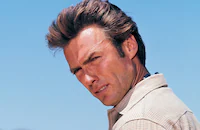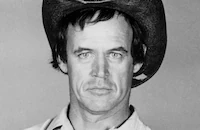Thunderbolt And Lightfoot
Brief Synopsis
Cast & Crew
Michael Cimino
Clint Eastwood
Jeff Bridges
Geoffrey Lewis
George Kennedy
Dub Taylor
Film Details
Technical Specs
Synopsis
When a young thief named Lightfoot inadvertently rescues veteran bank robber Thunderbolt by running over his pursuer, the two team up to find money from a heist that was never recovered.
Cast

Clint Eastwood

Jeff Bridges

Geoffrey Lewis

George Kennedy
Dub Taylor
Catherine Bach
Gary Busey
Jack Dodson
Gene Elman
Burton Gilliam
Roy Jenson
Claudia Lennear

Bill Mckinney
Vic Tayback

Gregory Walcott
Erica Hagen
Alvin Childress
Virginia Baker
Stuart Nisbet
Irene K Cooper
Cliff Emmich
June Fairchild
Ted Foulkes
Leslie Oliver
Mark Montgomery
Karen Lamm
Luanne Roberts
Lila Teigh
Crew
Edward Aiona
Bob Barber
Dee Barton
Sass Bedig
James Berkey
Kathryn Blondell
Wynn Bowles
Don Christie
Michael Cimino
William Clark
Robert Daley
Wayne Fitzgerald
Bert Hallberg
David Shamroy Hamburger
Carmon Howell
Jack Kosslyn
Tambi Larsen
Carey Loftin
Joe Mckinney
Hope Mclachlin
Jules Mellilo
Richard Meyer
Patricia Mock
Charles Okun
Richard Portman
Cliff D Ralke
Art Rimozius
Jerry Roberts
Carol Rydall
Arne L Schmidt
Abby Singer
Keith Stafford
Frank Stanley
Frank Stanley
Buddy Van Horn
Ferris Webster
Norman Webster
Paul H. Williams
Paul H. Williams
Glenn T Wright
Film Details
Technical Specs
Award Nominations
Best Supporting Actor
Articles
Thunderbolt and Lightfoot on Blu-ray
Cimino introduces the two characters in tandem in the opening scene: Eastwood playing preacher in a rural Midwest church while Bridges (dressed in a pair of black leather pants) smiles his way into the seat of a Trans Am on a used car lot. Before the sermon is over, a gunman (George Kennedy) steps into the church and opens fire on Eastwood's minister, who takes cover and makes his break with the calm focus of a man who is no stranger to such situations. As he runs from his would-be assassin, Lightfoot revs the engine and then takes off from the lot, leaving the salesman in a cloud of dust and confusion, and he inadvertently ends up playing getaway driver for Thunderbolt. A partnership is born of the chance meeting and Lightfoot clings to his reluctant new friend and mentor as they hit the road.
Thunderbolt's troubles all trace back to a vault robbery a few years ago. The heist was a success but the loot went missing (in fact, the entire hideout is gone) and Thunderbolt's surviving partners in crime, the hot-tempered Red Leary (George Kennedy at his most splenetic) and the amiably slow-witted Eddie Goody (Eastwood regular Geoffrey Lewis), think he double-crossed them and are on his trail for revenge. Once that confusion is cleared up (these guys aren't big on communication) Lightfoot suggests they simply do it again. After all, who would expect a second civilian assault on a government vault with military artillery?
It's an unexpected way into an offbeat caper film and Cimino lets it all roll out at a lazy stroll, interspersing action scenes and caper movie mechanics with bull sessions and comic interludes. There are plenty of cars careening through back road and off-road chases, including a merry little chase through a drive-in theater, but this film doesn't revel in the destruction of vehicles or the comic spectacle of property damage along the way. Lightfoot isn't a crack driver so much as a reckless speed demon--more leadfoot than Lightfoot when it comes to fast cars and off-road stunts--and his manic driving is simply a way to look for thrills and adventure, and perhaps to show off to Thunderbolt. He never hides his intentions: he wants to be friends. Behind that happy-go-lucky personality is a lonely drifter looking for connection.
Cimino sets it all against the bucolic countryside and nameless small towns of Montana, where time seems to run slower, if at all. All that gunplay and getaway driving seems strangely but lovingly out of place here, like they've taken a wrong turn out of a city street chase, until it suddenly swerves into some oddball side road. The script is dotted with such narrative rest areas and the Cimino and his actors have fun with them. When they get civilian jobs to put together a stake for the heist, the film downshifts into workplace comedy. When they meet up to plan the heist, good-natured ribbing over beers careens into personality conflicts as Lightfoot winds up an easily angered Red into an apoplectic froth. When they finally kick off the heist in the third act, where everyone has to hit their marks with precision timing, Cimino matches their precision without losing the personality of the picture or its characters.
Eastwood is ostensibly the star but mostly hangs back in the film, letting Bridges verbally dance around his scenes like an over-excited kid trying to impress the cool crowd. That mix of playfulness and earnestness is endearing and defining, and it earned Bridges his second Academy Award nomination. Kennedy played his share of bullheaded tough guys but Red is easily his meanest, most brutal character, running on bile and vengeance while holding on to his grudges until he has the opportunity to escalate things in his favor. Lewis's Goodie is his opposite, a sweet-natured soul who can't even point a gun without feeling guilty. Eastwood plays his usual lone wolf, lobbing terse comments and bitten-off responses as a defense against letting any emotion show, but his affection for Lightfoot clearly grows through the film. Dub Taylor and Gary Busey (identified as "Garey" in the credits) both have small but memorable parts.
Even though he ceded direction to Cimino, Eastwood clearly kept his hand in as producer (he wielded influence over every Malpaso film he made to a greater or lesser extent). The convergence of talents makes for a pleasing comingling of genres and personalities, while the atmosphere of the Eastwood troupe (and, of course, of Eastwood himself in the lead) helps shape the film in his image. Along with Lewis there are appearances by Bill McKinney is a back road character who give the boys a wild ride and Gregory Walcott as the used car salesman, and behind the scenes are producer Robert Daley, cinematographer Frank Stanley, and editor Ferris Webster, all part of Eastwood's regular company. They help shape the film into the easy-going mode that will come back in later Eastwood comedies, especially Bronco Billy (1980).
The meandering has a tendency to slow the film down to a pace more common to meandering road movies than focused caper films. The good company and comic asides keep it from stalling out and the strength of the central relationship anchors the diversions. But there's also an undercurrent of brutality unleashed in the final act, albeit one that carries its own sense of savage poetic justice. It gives the finale, a bittersweet coda that wraps back around to the shaggy dog tale origins, an added punch.
The Twilight Time disc features commentary by the usual Twilight Time crew of film historians: Twilight Time founder and veteran film documentarian Nick Redman, house essayist Julie Kirgo, and screenwriter Lem Dobbs. They discuss the production, celebrate Bridges' performance, talk about the themes that Cimino introduces into the film, and have a spirited debate over the issue of the homo-erotic subtext that many critics have suggested and many fans have denied (Julie Kirgo: "And that's the beauty of this film, there are many ways to read it!"), and in between they pick out notable scenes and moments for discussion. Also features the Twilight Time trademark isolated score track (featuring the laconic music of Dee Barton) and a booklet with notes on the film by film historian Julie Kirgo.
by Sean Axmaker

Thunderbolt and Lightfoot on Blu-ray
Quotes
You ain't no preacher, Preacher.- Lightfoot
Does he know everything?- Red Leary
No.- John Doherty
Yes.- Lightfoot
Hey were did you get those pants?- Lightfoot
You freak! I love you, come back!- Lightfoot
You don't look so good, kid.- John Doherty
I believe you're right.- Lightfoot
Thunderbolt and Lightfoot. That sounds like something.- Lightfoot
Hey. You stick with me kid. Your gonna live forever.- Lightfoot
Trivia
Michael Cimino was given the chance to write and direct this picture for Clint Eastwood after Eastwood was impressed with a rewrite Cimino did on the second "Dirty Harry" script, Magnum Force (1973).
When Michael Cimino was discussing the film with Jeff Bridges, he told Bridges it was Bridges job to make 'Clint Eastwood' laugh both on and off camera and he did.
Miscellaneous Notes
Released in United States 1998
Released in United States February 2010
Released in United States Summer June 1974
Shown at Santa Barbara International Film Festival (Special Presentation) February 4-14, 2010.
Shown at Vancouver International Film Festival September 26 - October 12, 1998.
Released in USA on video.
Released in United States 1998 (Shown at Vancouver International Film Festival September 26 - October 12, 1998.)
Released in United States February 2010 (Shown at Santa Barbara International Film Festival (Special Presentation) February 4-14, 2010.)
Released in United States Summer June 1974














